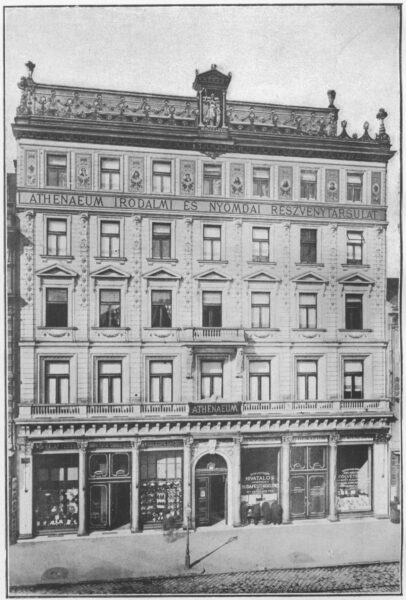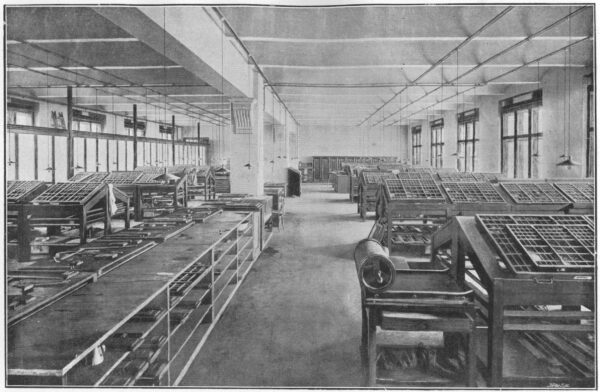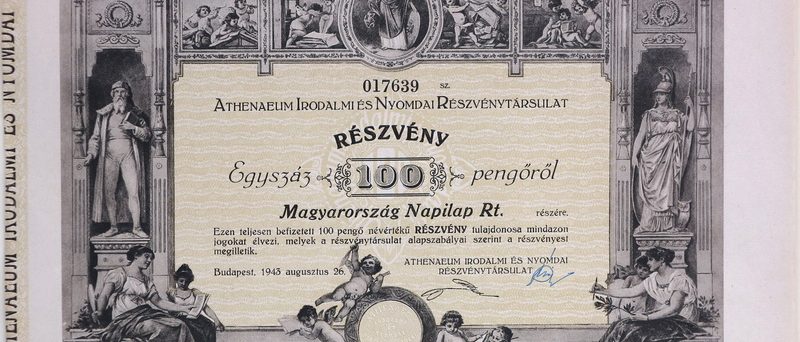"Athenaeum" literary and printing ltd
From Athenaeum Publishing House From its founding in 1841 until 1948, it published the works of the most important writers and poets of the time and thus played a decisive role in Hungarian literature. From 1948 to 1998 it operated exclusively as a printing house, since then it has been publishing books on a limited scale, but is now also publishing again.
History
Business of Gusztáv Emich
Athenaeum Book Publishing was created from a bookshop, which was Gusztáv Emich opened in Pest on 1 December 1841. Like most bookshops of the time, it also functioned as a lending library and had the character of an art shop. Unlike his contemporaries, however, Emich was also a book publisher (at the time, this was more the preserve of the printers) and a year after opening the shop, he had already published his own book. The number of their publications gradually increased, for example, by the time of the War of Independence they had published 32 works, and in 1850 they bought their own printing press, making Emich one of the first in Hungary to own a printing press, publishing house and bookshop in one.
Their main profile was the publication of fiction in Hungarian, with an emphasis on contemporary authors. They supported a number of young writers and poets, among them Sándor Petőfi, whose first book was published in 1845. Pearls of Love and who later became Emich's regular publisher. Petőfi had a friendly relationship with Gusztáv Emich, not just a working relationship, and his name later became associated with the publisher, becoming its emblematic figure. After his death, Athenaeum took over the publishing management of his works, and held the exclusive publishing rights to his oeuvre for 30 years after his death.
Many of our major literary works of the reform era were published by Emich, including Madách's The Tragedy of Man, József Eötvös' The Village Notary, 44 Jókai novels, and works by Zsigmond Kemény and János Vajda. In addition to publishing books, he also published 25 journals, such as the Pesti Napló, the journal of the Hungarian Academy of Sciences, the New Hungarian Museum, A Hont, the Fővárosi Lapokat and the Fővárosi Lapokat, and the élclapot "Mad Miska".
By the 1860s, Emich had become one of Hungary's largest publishers, employing more than 200 people in its printing works alone. He published a total of 663 works, 629 of which were published in Hungarian. One of their most important undertakings was the publication of a facsimile of the Pictorial Chronicle, which was printed with woodcuts on hand-press and won a gold medal at the 1867 Paris World Exhibition. The Hungarian Academy of Sciences awarded Emich the title of "Academic Printer".
The Athenaeum Literary and Printing Company Ltd.

Id. Gusztáv Emich the publisher was incorporated as a joint-stock company on 28 June 1868, when it took the name "Athenaeum Literary and Printing Company". The first director was Károly Osterlamm, and the board members included Id. Gusztáv Emich in addition to Jr. Gusztáv Emich, Zsigmond Kemény and Mór Jókai.

At the beginning of the 20th century Athenaeum continued to operate as a joint-stock company, with Miklós Andorvolt Miklós as its chairman and leading figure from 1917. Other board members included Zsigmond Móricz, Ferenc Molnár, Lajos Zilahy and Jenő Heltai, but only the latter had a significant say in the affairs of the publishing house. Andor Miklós was primarily a businessman in his approach to the publishing house, and had less understanding of literature. Zsigmond Móricz wrote of him. He does not read a single book. He has no idea who János Arany was, when he talks about a writer sometimes, you stop to think."[1] Despite this, and mainly thanks to its highly literary-minded advisors, Athenaeum remained a liberal-minded publishing house, publishing the best of contemporary literature. The poet György Sárközi played an important role in this, and was one of the most progressive directors of the publishing house, launching a number of initiatives.
The publisher had a close relationship with the writers of the West: almost all the first generation had books published by Athenaeum, and the most important ones became its permanent publishers. Zsigmond Móricz, Mihály Babits and Frigyes Karinthy were bound to the publisher by a lifetime contract, and they published several Krúdy novels and volumes by Dezső Kosztolányi, Árpád Tóth, Lőrinc Szabó, Milan Füst and Géza Csáth, among others. They were particularly successful in the management of the legacy of Endre Ady and the publication of all his works: between the two world wars, Ady became so popular that some of his volumes sold an unprecedented 15-20 000 copies.
The newspaper group Az Est, which was also owned by Andor Miklós, was connected to the activities of the Athenaeum publishing house, which provided regular publication opportunities and work for many writers and poets in the publishing house's sphere of influence.
The Athenaeum after the Second World War
The Second World War the end of the Athenaeum, the Athenaeum's printingand, after the Red Army had briefly used for its own purposes, it came under left-wing leadership. A former printing worker, Sándor Palkó is the new CEO. The old owners tried to regain their ownership: the former CEO, Sándor Török and widow of Andor Miklós, Frida Gombaszögi also sued the company, but these lawsuits dragged on, and the Nationalisation in 1948 put an end to them for good. From then on, Athenaeum ceased to exist as a publishing house and continued to operate only as a printing house. The name was changed to Athenaeum Printing House National Enterprise, and during nationalisation 49 smaller printing houses were merged into it and large-scale production was started. Among other things, textbooks were printed here in very large numbers and some 60 periodicals were produced, e.g. Women's Journal and the Life and Science.
Sources
- István Kiss:The History and Role of Athenaeum Book Publishing House in Hungarian Literature. Budapest, Akadémiai Kiadó, 1980. ISBN 9630519372
- Ágnes Bánáti - Dénes Sándor: The Athenaeum at 100. 1868-1968. Budapest, Akadémiai Kiadó, 1968.
- Tamás Torzsai - Imre Zala: Book A-Z. A small encyclopaedia of the book trade. Budapest, School Book Publishing House, 1973.
- Jump up↑ Móricz Virág: My father's novel, 1954, page 315. Cited by: Géza Lengyel. Hungarian newspaper magnates. Budapest: Akadémiai Könyvkiadó, p. 63 (1963)
Source: wikipedia
Date of foundation: 28.06.1868.
Date of cessation: 1948
Founders: Gusztáv Emich
Securities issued:
| "Athenaeum" literary and printing r.-t. |
Decisive leaders:
1868 | Gusztáv Emich |
1868 | Zsigmond Kemény |
1868 | Mór Jókai |
1868 | ifj. Gusztáv Emich |
1868 | Károly Osterlamm |
Main activity: publishing
Main products:
1868 | Pest newspaper |
Seats:
1868 | Pest, Rákóczi út 54. |
Locations:
1977 | 1106 Budapest, Kozma u. 2. |
Author: by Radnai Márton

Date of foundation: 28.06.1868.
Founders: Gusztáv Emich
Decisive leaders:
1868 | Gusztáv Emich |
1868 | Zsigmond Kemény |
1868 | Mór Jókai |
1868 | ifj. Gusztáv Emich |
1868 | Károly Osterlamm |
Main activity: publishing
Main products:
1868 | Pest newspaper |
Seats:
1868 | Pest, Rákóczi út 54. |
Locations:
1977 | 1106 Budapest, Kozma u. 2. |
Main milestones are not set
Author: by Radnai Márton
"Athenaeum" literary and printing ltd
From Athenaeum Publishing House From its founding in 1841 until 1948, it published the works of the most important writers and poets of the time and thus played a decisive role in Hungarian literature. From 1948 to 1998 it operated exclusively as a printing house, since then it has been publishing books on a limited scale, but is now also publishing again.
History
Business of Gusztáv Emich
Athenaeum Book Publishing was created from a bookshop, which was Gusztáv Emich opened in Pest on 1 December 1841. Like most bookshops of the time, it also functioned as a lending library and had the character of an art shop. Unlike his contemporaries, however, Emich was also a book publisher (at the time, this was more the preserve of the printers) and a year after opening the shop, he had already published his own book. The number of their publications gradually increased, for example, by the time of the War of Independence they had published 32 works, and in 1850 they bought their own printing press, making Emich one of the first in Hungary to own a printing press, publishing house and bookshop in one.
Their main profile was the publication of fiction in Hungarian, with an emphasis on contemporary authors. They supported a number of young writers and poets, among them Sándor Petőfi, whose first book was published in 1845. Pearls of Love and who later became Emich's regular publisher. Petőfi had a friendly relationship with Gusztáv Emich, not just a working relationship, and his name later became associated with the publisher, becoming its emblematic figure. After his death, Athenaeum took over the publishing management of his works, and held the exclusive publishing rights to his oeuvre for 30 years after his death.
Many of our major literary works of the reform era were published by Emich, including Madách's The Tragedy of Man, József Eötvös' The Village Notary, 44 Jókai novels, and works by Zsigmond Kemény and János Vajda. In addition to publishing books, he also published 25 journals, such as the Pesti Napló, the journal of the Hungarian Academy of Sciences, the New Hungarian Museum, A Hont, the Fővárosi Lapokat and the Fővárosi Lapokat, and the élclapot "Mad Miska".
By the 1860s, Emich had become one of Hungary's largest publishers, employing more than 200 people in its printing works alone. He published a total of 663 works, 629 of which were published in Hungarian. One of their most important undertakings was the publication of a facsimile of the Pictorial Chronicle, which was printed with woodcuts on hand-press and won a gold medal at the 1867 Paris World Exhibition. The Hungarian Academy of Sciences awarded Emich the title of "Academic Printer".
The Athenaeum Literary and Printing Company Ltd.

Id. Gusztáv Emich the publisher was incorporated as a joint-stock company on 28 June 1868, when it took the name "Athenaeum Literary and Printing Company". The first director was Károly Osterlamm, and the board members included Id. Gusztáv Emich in addition to Jr. Gusztáv Emich, Zsigmond Kemény and Mór Jókai.

At the beginning of the 20th century Athenaeum continued to operate as a joint-stock company, with Miklós Andorvolt Miklós as its chairman and leading figure from 1917. Other board members included Zsigmond Móricz, Ferenc Molnár, Lajos Zilahy and Jenő Heltai, but only the latter had a significant say in the affairs of the publishing house. Andor Miklós was primarily a businessman in his approach to the publishing house, and had less understanding of literature. Zsigmond Móricz wrote of him. He does not read a single book. He has no idea who János Arany was, when he talks about a writer sometimes, you stop to think."[1] Despite this, and mainly thanks to its highly literary-minded advisors, Athenaeum remained a liberal-minded publishing house, publishing the best of contemporary literature. The poet György Sárközi played an important role in this, and was one of the most progressive directors of the publishing house, launching a number of initiatives.
The publisher had a close relationship with the writers of the West: almost all the first generation had books published by Athenaeum, and the most important ones became its permanent publishers. Zsigmond Móricz, Mihály Babits and Frigyes Karinthy were bound to the publisher by a lifetime contract, and they published several Krúdy novels and volumes by Dezső Kosztolányi, Árpád Tóth, Lőrinc Szabó, Milan Füst and Géza Csáth, among others. They were particularly successful in the management of the legacy of Endre Ady and the publication of all his works: between the two world wars, Ady became so popular that some of his volumes sold an unprecedented 15-20 000 copies.
The newspaper group Az Est, which was also owned by Andor Miklós, was connected to the activities of the Athenaeum publishing house, which provided regular publication opportunities and work for many writers and poets in the publishing house's sphere of influence.
The Athenaeum after the Second World War
The Second World War the end of the Athenaeum, the Athenaeum's printingand, after the Red Army had briefly used for its own purposes, it came under left-wing leadership. A former printing worker, Sándor Palkó is the new CEO. The old owners tried to regain their ownership: the former CEO, Sándor Török and widow of Andor Miklós, Frida Gombaszögi also sued the company, but these lawsuits dragged on, and the Nationalisation in 1948 put an end to them for good. From then on, Athenaeum ceased to exist as a publishing house and continued to operate only as a printing house. The name was changed to Athenaeum Printing House National Enterprise, and during nationalisation 49 smaller printing houses were merged into it and large-scale production was started. Among other things, textbooks were printed here in very large numbers and some 60 periodicals were produced, e.g. Women's Journal and the Life and Science.
Sources
- István Kiss:The History and Role of Athenaeum Book Publishing House in Hungarian Literature. Budapest, Akadémiai Kiadó, 1980. ISBN 9630519372
- Ágnes Bánáti - Dénes Sándor: The Athenaeum at 100. 1868-1968. Budapest, Akadémiai Kiadó, 1968.
- Tamás Torzsai - Imre Zala: Book A-Z. A small encyclopaedia of the book trade. Budapest, School Book Publishing House, 1973.
- Jump up↑ Móricz Virág: My father's novel, 1954, page 315. Cited by: Géza Lengyel. Hungarian newspaper magnates. Budapest: Akadémiai Könyvkiadó, p. 63 (1963)
Source: wikipedia

